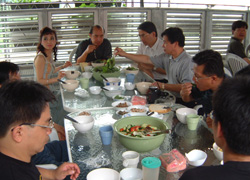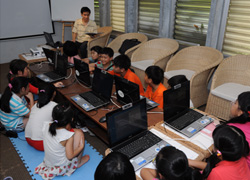Message From Taiwan For SASBE 2012Before Forever; After Tomorrow◎Global Warming and Climate ChangeGlobal warming and climate change have become the focus of world concern. Governments and NGOs have been deeply involved in the studies of this complex issue. Among them, the most representative study would be the IPCC report. Currently, the international community has used the IPCC report as the basis for their attempts to grasp the context of climate change and propose response strategies. Generally, the international community has recognized the coping strategies in two dimensions-"mitigation" and "adaptation".
◎The Limitations of the IPCC ReportWe have also taken reference of the IPCC report with an expectation to put the pieces together in terms of climate change and its impacts. However, when we compared the inferences proposed in the IPCC report to the ultra-scale composite-type disasters occurred around the world in the recent period, we found that the conclusions published in the the IPCC report have virtually no explaining or predictive power. The reason may have been that IPCC has ruled out the changes in the nature right from the beginning and only locked on to the differences in carbon dioxide emissions to search for the possible outcomes from different scenario assumptions. Such result may have some reference value for the "mitigation" theory but would be rather limited for the "adaptation" strategy.
◎Our actionsIn view of the IPCC's inadequate assumption that cannot explain the occurred phenomena, in the face of the serious issues of climate change that has been jeopardizing the lives of mankind, we are forced to use our own ways in parallel to the IPCC research for a series of studies. In 2004, we began to explore the possible causes of climate change. In 2005, we proposed the temperature fluctuation estimation model, and explored the impact of climate change on the natural environment and human society. In 2007, we began to develop the eco-city transformation procedures and discuss the direction of possible development of a new human civilization under the threat of climate change. In 2008, we put forward the timetable of climate change, assessed the climate risk for each country, and predicted the disaster types likely to occur in the different places. In 2010, the self-checking model was compared to the occurred phenomena for verification of the reliability. In the following section, we will present the results of our research arrived at this stage.
◎Our EffortsTaiwan has a comparative advantage for disaster avoidance and construction of a balance self-restoring mechanism for the Earth. We strive to build Taiwan into a cradle of a new civilization. Therefore, we will work to provide timely advises for policymaking and help the government to build a strong response mechanism.
(1)The Framework of National Sustainable Development Policies: http://nsdn.epa.gov.tw/We will supplement the previous research findings with the "Ecosystem Abnormality Disaster Mitigation Strategies" and "Epidemic Prevention and Remedy Measures". At the same time, we will review the strategies and goals in the different dimensions planned in the framework, including the environment, society, and economy, based on the symbiotic concept, propose relevant action plans to the relevant authorities, and verify whether the policies conform to the sustainable development indicators.
(2)The Framework of National Climate Change Mitigation Policies (Draft): http://www.cepd.gov.tw/Based on the forecast of the disaster occurring schedule with emphasis on the urgency, we will send out warnings for the possible impacts and challenges in each area of mitigation; we will pay attention to the possibility of composite catastrophes built up by the regularly occurring disasters. We should isolate incidents of regularly occurring disasters to prevent prolonged impacts. In addition, we should also make an attempt to reserve certain level of energy for the challenges of unknown disasters in the future.
(3)Eco-City TransformationFor the part that is closer to the lives of the general public, we are currently developing the "Seven Steps to Eco-City Transformation" based on "The Framework of National Sustainable Development Policies" and "The Framework of National Climate Change Mitigation Policies". We picture the seven steps as seven steps of a stairway, and each city is placed on a different level of this stair to indicate their different needs in the process of transformation. Cities with more intact ecosystems may need only three steps to successfully transform into eco-cities. However, the ecosystems of most cities have been completely destroyed, so they may need up to seven steps to achieve the goal. The following is a brief description of the seven steps:
A. Preservation of water and trees;B. Biodiversity;C. Environmental engineering;D. Environmental surveillance;E. Urban design;F. Green building;G. New civilization: Through self-moderating and self-sufficient living, digitalized communication, and self-fulfillment values, collective change can be developed into norms generally practiced in a society.
The seven steps form a full process and completion of the seven steps will bring the mankind into the age of a new civilization.  On August 31st 2002, President Lin Chun-shin and Judy, Huang Chin-ying led the Archilife team to host a tour of Symbiosphere 1 Center (green building). Professor Chiang Che-ming from Cheng Kung University, Deputy Principal of Taipei Medical University Su Ching-hua, and Principal of Central Taiwan University of Science and Technology Li Hong-mo are invited to experience a symbiotic banquet (nucleic acid meals) and the SB=GB+Symbiosis living.
On August 31st 2002, President Lin Chun-shin and Judy, Huang Chin-ying led the Archilife team to host a tour of Symbiosphere 1 Center (green building). Professor Chiang Che-ming from Cheng Kung University, Deputy Principal of Taipei Medical University Su Ching-hua, and Principal of Central Taiwan University of Science and Technology Li Hong-mo are invited to experience a symbiotic banquet (nucleic acid meals) and the SB=GB+Symbiosis living. From August 1st to 5th 2011, Archilife organized a summer camp at Symbiosphere 1 Center (green building). For digitalization, the Archilife Research Foundation continued the "Digital Software Creativity" program set up by the new generation member Mr. Lin Rong-sheng. This program illustrates how to use simple programming language to create fun game apps for phones and leads the participants to experience digitalized living.
From August 1st to 5th 2011, Archilife organized a summer camp at Symbiosphere 1 Center (green building). For digitalization, the Archilife Research Foundation continued the "Digital Software Creativity" program set up by the new generation member Mr. Lin Rong-sheng. This program illustrates how to use simple programming language to create fun game apps for phones and leads the participants to experience digitalized living.